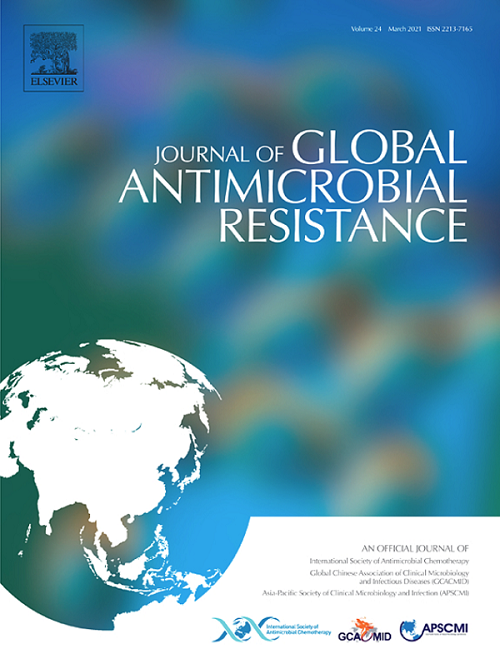Genomic insights into multidrug-resistant Enterobacter hormaechei isolates from seafood at retail carrying the mcr-9 gene and other resistance determinants on IncHI2 plasmids
IF 3.2
3区 医学
Q2 INFECTIOUS DISEASES
引用次数: 0
Abstract
Objectives
We aimed to characterise the genomic features of two multidrug-resistant (MDR) isolates from retail seafood samples.
Methods
Antimicrobial susceptibility was determined by minimum inhibitory concentration (MIC) tests. Genome sequences were obtained by hybrid sequences of short and long.
Results
The two MDR (ampicillin, cefotaxime, ciprofloxacin, ceftazidime, nalidixic acid, gentamicin, tetracycline, sulfamethoxazole, cefoxitin, and trimethoprim) Enterobacter hormaechei (E. hormaechei) isolates belonged to ST114. Nineteen antibiotic resistance genes (ARGs), including mcr-9, were identified in the genomes. The mcr-9 and other resistance determinants were on an IncHI2 plasmid. Sequence analysis showed mutations in genes implicated in colistin resistance, of which a non-conservative one was present in the qseB. Virulence genes of T6SS or involved in motility were identified in both genomes. Comparison of mcr-9 plasmids allowed us to identify similar plasmids in the isolates from Italy and in the five best hits of the PLSDB database, with some regions of difference in the MDR region. A genome cluster analysis grouped our isolates into the same clade of ST114 E. hormaechei isolated from humans in Guadeloupe in 2018 and Switzerland in 2019, most of which harboured an IncHI2 replicon but not the mcr-9 gene.
Conclusions
The finding of MDR E. hormaechei in seafood, carrying the mcr-9 and other resistance determinants on IncHI2 plasmids, enhances our understanding of antimicrobial resistance (AMR) and highlights the importance of gaining more data on the occurrence and circulation of AMR and ARGs in aquatic environments, in order to better understand sources, transmission routes, and evolution of AMR mechanisms.
零售海产品中携带mcr-9基因和IncHI2质粒上其他耐药决定因素的多重耐药霍氏肠杆菌分离株的基因组分析
目的:我们旨在描述零售海产品样本中两种多药耐药(MDR)分离株的基因组特征。方法:采用最小抑菌浓度(MIC)法测定药敏。基因组序列由短序列和长序列杂交得到。结果:2株耐药菌株(氨苄西林、头孢噻肟、环丙沙星、头孢他啶、萘啶酸、庆大霉素、四环素、磺胺甲恶唑、头孢西丁和甲氧苄啶)均属于ST114。在基因组中鉴定出包括mcr-9在内的19个抗生素耐药基因(ARGs)。mcr-9和其他耐药决定因子位于IncHI2质粒上。序列分析显示与粘菌素耐药相关的基因发生突变,其中一个非保守基因存在于qseB中。在两个基因组中都鉴定出了T6SS或参与运动性的毒力基因。比较意大利分离株的mcr-9质粒和PLSDB数据库中5个最佳命中的mcr-9质粒,其中MDR区存在一些差异。基因组聚类分析将我们的分离株归为2018年在瓜德罗普岛和2019年在瑞士从人类身上分离到的ST114荷马大肠杆菌的同一分支,其中大部分含有IncHI2复制子,但没有mcr-9基因。结论:在海产品中发现携带mcr-9和其他耐药决定因素的耐多药E. hormaechei,增强了我们对抗菌素耐药性(AMR)的认识,并强调了获取更多AMR和ARGs在水生环境中发生和传播的数据的重要性,以便更好地了解AMR的来源、传播途径和进化机制。
本文章由计算机程序翻译,如有差异,请以英文原文为准。
求助全文
约1分钟内获得全文
求助全文
来源期刊

Journal of global antimicrobial resistance
INFECTIOUS DISEASES-PHARMACOLOGY & PHARMACY
CiteScore
8.70
自引率
2.20%
发文量
285
审稿时长
34 weeks
期刊介绍:
The Journal of Global Antimicrobial Resistance (JGAR) is a quarterly online journal run by an international Editorial Board that focuses on the global spread of antibiotic-resistant microbes.
JGAR is a dedicated journal for all professionals working in research, health care, the environment and animal infection control, aiming to track the resistance threat worldwide and provides a single voice devoted to antimicrobial resistance (AMR).
Featuring peer-reviewed and up to date research articles, reviews, short notes and hot topics JGAR covers the key topics related to antibacterial, antiviral, antifungal and antiparasitic resistance.
 求助内容:
求助内容: 应助结果提醒方式:
应助结果提醒方式:


